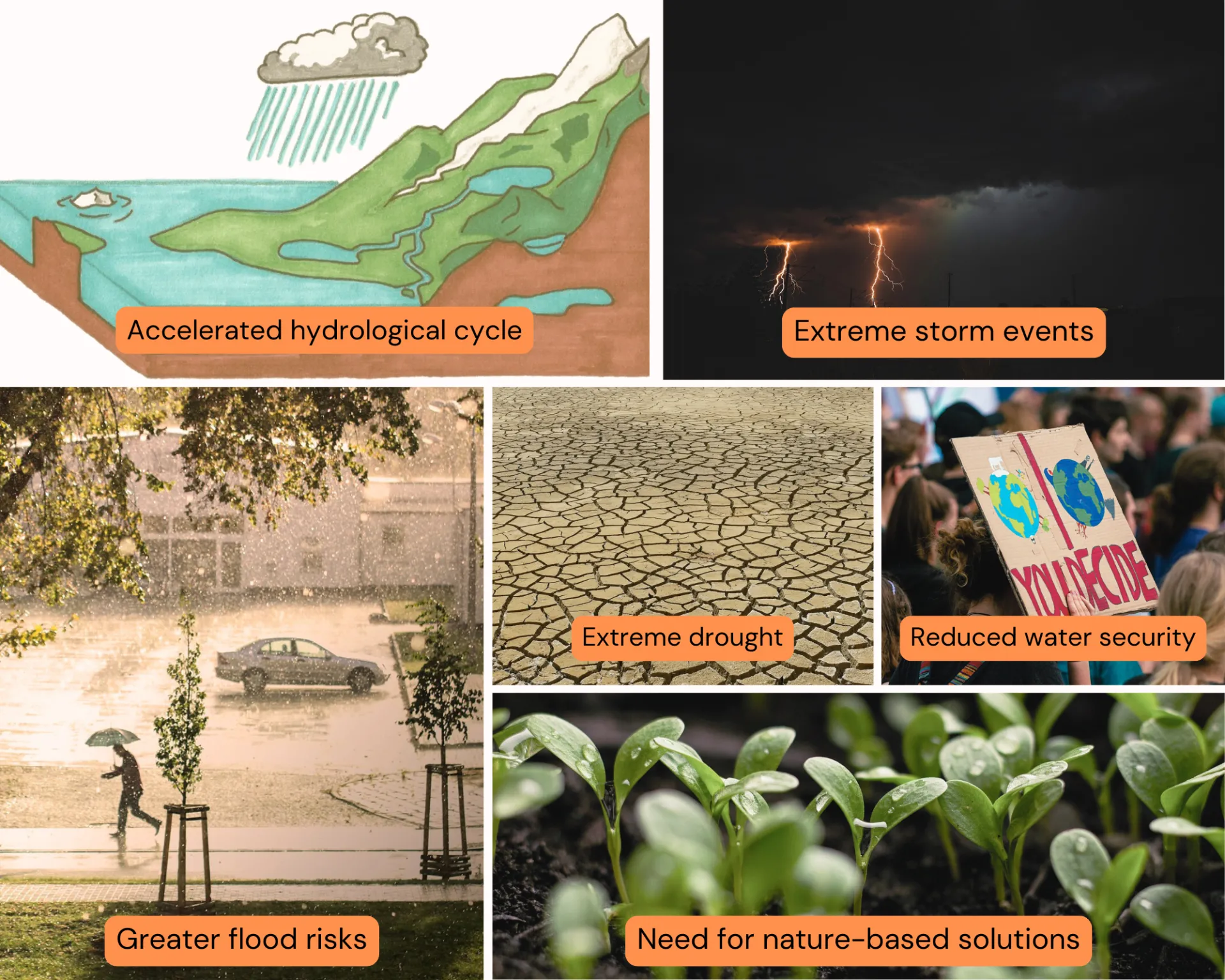The Impact of Climate Change on Stormwater Management

Climate change is affecting all parameters of the environmental spectrum and thus, all aspects of life. Regarding water resilience, the lingering effects of climate change play a significant role in limiting access to water whilst also increasing demand for water supplies across the nation and most especially in Southern California. Climate change’s acceleration of the hydrological cycle has also increased risks of extreme storm and drought events for most regions, especially semi-arid regions. Nature-based solutions (NBS), when designed in response to projected climate change impacts, can offer practical and cost-effective adaptive strategies for stormwater management to confront and mitigate the ecological damage caused by climate change. This post will explore how climate change affects stormwater management in Southern California, explain how NBS can help adapt to climate change, and list recommended strategies for climate change-resilient stormwater management practices.
The Impact of Climate Change on Precipitation Patterns and Runoff
Climate change can significantly affect water availability through its direct impact on precipitation intensity and frequency. Changes in the character of precipitation largely depend on variability patterns of atmospheric circulation (changes in precipitation are correlated with climate change). Climate change is associated mainly with some of these observed circulation changes. Its contribution to the increase in global temperatures has allowed for oceans & local water bodies to become warmer, snow to melt faster, and rates of evaporation to occur more quickly. This can intensify the hydrological cycle and increase the volume of water vapor in our atmosphere, which can lead to a greater risk of extreme storm events over storm affected coastal areas. A matter that would drastically increase stormwater runoff and create several serious environmental health hazards for susceptible communities within Southern California (Climate Change Indicators: Heavy Precipitation). On the other hand, other southwest areas located away from storm tracks will only become more vulnerable to droughts.
Impacts of Climate Change on Stormwater Systems: Numerous studies have highlighted the climate-induced stressors affecting urban hydrology. For instance, Pierce et al. (2018) project that Southern California will face fewer but more intense storm events. This shift will place significant pressure on existing stormwater systems, which were originally designed to manage lower peak flows. Urban areas with high levels of impervious surfaces are particularly susceptible to flash flooding and degradation of water quality as precipitation patterns change.
Impacts of Climate Change on Sea-level Rise: Sea-level rise and rising groundwater tables in coastal cities like Los Angeles and Long Beach add additional complexity. As noted by Sweet et al. (2017), sea-level rise exacerbates tidal backflow and drainage capacity issues, especially where gravity-fed systems are still in place.
How Nature-Based Solutions Can Help Adapt to Climate Change
Nature-based solutions are a collection of multi-purpose approaches aiming to increase resilience to climate change. Seen as an effective and economical adaptation measure, these eco-friendly projects often have larger co-benefits and cost as much as two to five times less than what an engineered project would (What are nature-based solutions to climate change?). Although they cannot work as a sole response to climate change, well-designed NBS can play a crucial role in enhancing water security, improving carbon sequestration, and reducing temperatures over the remainder of the century. Practices like the restoration of wetlands, preservation of rivers/floodplains, and protection of coastal zones can help stabilize shorelines and dissipate wave energy to reduce chances of flooding and erosion occurring in local communities throughout Southern California (Nature-based Solutions).
Examples of Adaptive Stormwater Management Strategies
There exists a multitude of sustainable adaptive strategies people can adopt for climate change. However, the effectiveness of these nature-based solutions is highly dependent on the local context. Regardless of regional variability, it is always recommended to consider technical standards, collaborative governance, knowledge transfer, capacity building, and sufficient funding for proper implementation. Community members are encouraged to practice Integrated Water Resources Management (IWRM): a process that promotes the “coordinated development and management of water, land, and related resources in order to maximize the resultant economic and social welfare in an equitable manner without compromising the sustainability of vital ecosystems” (Global Water Partnership, 2000). Below are some ways that one can engage in IWRM.
- Natural Infrastructure: Integrating ecological solutions into urban planning can enhance resilience against water-related challenges. Features like green roofs, rain gardens, and permeable pavements help manage stormwater, improve water quality, and create livable spaces that are resilient to extreme rain events.
- Water Conservation: In urban landscapes, water conservation encompasses the implementation of low-impact development practices, such as rainwater harvesting and greywater reuse. Encouraging sustainable water use reduces stormwater runoff, enhances water security, and supports the overall sustainability of urban environments.
- Flood Hazard Mitigation: Flood hazard mitigation refers to strategies aimed at reducing flooding risks in urban areas. This includes constructing floodwalls, levees, and establishing well-planned evacuation routes. These measures protect communities by managing floodwaters and ensuring safety during extreme weather events.
- Ecosystem Restoration: Ecosystem restoration in urban landscapes involves rehabilitating natural areas such as wetlands, rivers, and coastal zones. By preserving these ecosystems, cities can stabilize shorelines, dissipate wave energy, and enhance natural flood defenses, thereby reducing flooding and erosion risks.
- Planting Drought-Resistant Crops: Incorporating drought-resistant crops into urban agriculture significantly lowers water usage and supports food production in arid regions. Additionally, promoting native plants in landscaping enhances water conservation and biodiversity, contributing to healthier urban ecosystems.
- Urban Drainage Systems: Urban drainage systems are designed to manage stormwater runoff effectively within cities. By handling runoff locally, these systems reduce the burden on traditional sewage infrastructure, help prevent flooding, and improve water quality in urban waterways.
Recommendations for Future Stormwater Planning
- Community Outreach & Engagement: Engage your local communities to address local stormwater concerns and solutions.
- Involve stakeholders in the planning and implementation of stormwater management strategies
- Promote educational campaigns and incentive programs to highlight the importance of reducing impervious surfaces and encourage the adoption of green infrastructure practices on both public and private properties
- Equity-Focused Implementation: Many underserved communities lack access to green infrastructure. Programs must be designed to equitably distribute benefits and prioritize flood-prone areas with socio-economic vulnerabilities (Mitchell et al., 2020).
- Smart Technology Integration: Use advanced stormwater modeling tools to predict runoff volumes better and determine high-priority areas for intervention.
- Real-time monitoring sensors that track rainfall intensity and runoff volume
- Adaptive control systems that can adjust to stormwater management practices based on real-time data
- Incorporate the potential forecast of precipitation patterns into design calculations
- More Green Infrastructure: Promote a culture of green infrastructure that will help improve stormwater volume management and provide sustainable long-term cost benefits.
- Develop comprehensive maintenance strategies so that community members can ensure proper longevity of green infrastructure practices
- Ensure that all stormwater management practices adhere to local and state regulations
- Incorporate permeable pavements, rain gardens, bioswales, green roofs, etc. for enhanced runoff reduction, water filtration, and urban temperature cooling
- Interagency Collaboration: Coordinated regional strategies between water agencies, municipalities, and community groups increase implementation success (Wong & Brown, 2009).
References
1. US EPA. (2022, October 18). Climate Change Impacts on Freshwater Resources. Www.epa.gov. https://www.epa.gov/climateimpacts/climate-change-impacts-freshwater-resources
2. UCAR. (2021). The Water Cycle and Climate Change. Scied.ucar.edu; UCAR. https://scied.ucar.edu/learning-zone/climate-change-impacts/water-cycle-climate-change
3. NASA. (2022). How does climate change affect precipitation? | NASA Global Precipitation Measurement Mission. Gpm.nasa.gov; NASA. https://gpm.nasa.gov/resources/faq/how-does-climate-change-affect-precipitation
4. Center for Climate and Energy Solutions. (2019, July 12). Extreme Precipitation and Climate Change | Center for Climate and Energy Solutions. Center for Climate and Energy Solutions. https://www.c2es.org/content/extreme-precipitation-and-climate-change/
5. Rosenberger, L., Leandro, J., Pauleit, S., & Erlwein, S. (2021). Sustainable stormwater management under the impact of climate change and urban densification. Journal of Hydrology, 596, 126137. https://doi.org/10.1016/j.jhydrol.2021.126137
6. Stormwater Best Management Practices. (n.d.). SPC Water Resource Center. https://spcwater.org/topics/stormwater-management/stormwater-best-management-practices-2/
7. Results, W. E. F.-R. to. (n.d.). WEF - Rainfall to Results. Www.wef.org. https://www.wef.org/topics/practice-areas/stormwater-and-watershed-management/rainfall-to-results/
8. Take Action. (2015). Noaa.gov. https://coast.noaa.gov/stormwater-floods/explore/
9. Mitchell, B. C., et al. (2020). Prioritizing green infrastructure for climate resilience and environmental justice. Sustainability, 12(3), 795.
10. Pierce, D. W., et al. (2018). Climate, drought, and sea level rise scenarios for California. Climatic Change, 150(3-4), 377–391.
11. Sweet, W. V., et al. (2017). Global and Regional Sea Level Rise Scenarios for the United States. NOAA Technical Report NOS CO-OPS 083.
12. Wong, T. H. F., & Brown, R. R. (2009). The water sensitive city: principles for practice. Water Science & Technology, 60(3), 673–682.
About the Authors

Daniel Gonzalez II is an associate research and extension specialist at SCREC under the Grizzly Corps Fellowship Program. He focuses on researching and developing nature-based solutions for stormwater management practices in Southern California. Drawing from his background as a certified K-12 educator, Daniel is excited to make watershed and climate-resilient resources more accessible for local communities across Southern California.
Contact at dgonzalezll@berkeley.edu

Dr. Esther N Lofton is an Urban Watershed Resilience Advisor serving Orange, Los Angeles, San Bernardino, and Riverside Counties. She focuses on drinking and environmental water quality, water use efficiency, water supply security, and water equity. Her research is conducted at various scales, such as surface and ground water basins, watersheds, neighborhoods, and field or household scales. Her research is geared towards providing recommendations and guidance to stakeholders such as watershed and stormwater managers, policy makers, and the public to make better decisions on water resources management.
Contact at enmosase@ucanr.edu or (858) 282-6737
